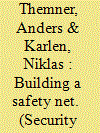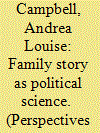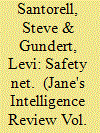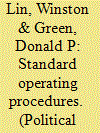|
|
|
Sort Order |
|
|
|
Items / Page
|
|
|
|
|
|
|
| Srl | Item |
| 1 |
ID:
171985


|
|
|
|
|
| Summary/Abstract |
The disarmament, demobilization, and reintegration of ex-combatants has become an integral part of peacebuilding. Although the main purpose of such interventions is to dissolve the military structures of armed groups, there is growing evidence that ex-combatant networks often remain intact. We investigate why such structures continue to thrive. We argue that ex-military networks are stronger when ex-commanders have weak links to elite patronage systems. Ex-combatants who are unable to rely on their former superiors for economic assistance must instead build denser ties to each other to gain access to a social safety net. To assess our argument, we conduct a comparative social network analysis (SNA) of two ex-military networks in Liberia. This innovative approach helps us uncover previously overlooked, but central, dynamics related to ex-combatant groups. We thereby show that SNA provides a range of underutilized tools and exact definitions that can increase our understanding of ex-military networks.
|
|
|
|
|
|
|
|
|
|
|
|
|
|
|
|
| 2 |
ID:
140417


|
|
|
|
|
| Summary/Abstract |
Three decades of financial crises culminating in the global financial crisis have prompted the development of multilayered global financial governance. This article examines the relationship between the global and regional layers by analyzing the case of the global and ASEAN+3 financial safety nets. Making use of regime theory, we examine the evolution of the characteristics, main institutions, goals, and behavioral expectations of these two nets. The article argues that the ASEAN+3 regional financial safety net, which was mostly developed following the East Asian financial crisis of 1997, complements rather than undermines the global financial safety net. Similar characteristics, goals, and behavioral expectations underpin this complementarity.
|
|
|
|
|
|
|
|
|
|
|
|
|
|
|
|
| 3 |
ID:
142739


|
|
|
|
|
| Summary/Abstract |
Intimate ethnography presents a number of challenges: How could I write about my own family in a way that was true to their experience but also an “objective” report? How could I convey telling details without robbing my family of their privacy? How could I rein in my emotions to report their story, and did I pick and choose facts to protect them or to make them more sympathetic? How could I generalize from their experience to that of millions of social assistance recipients? In this Reflections essay, I consider these challenges in light of what other social scientists have said about the issues of close work with individual, sometimes vulnerable, research subjects.
|
|
|
|
|
|
|
|
|
|
|
|
|
|
|
|
| 4 |
ID:
086098


|
|
|
|
|
| Publication |
2009.
|
| Summary/Abstract |
On 16 September 2008, a cybercriminal using the nickname Master Splyntr announced he was closing a forum on the website www.darkmarket.ws, saying: "Recent events have proven that despite our best efforts to expel and deactivate the accounts of suspected law enforcement, reporters and security agents, it is obvious that we have not been entirely successful."
The demise of this forum, which had been primarily dedicated to facilitating the communication and trade between data thieves, forgers and fraudsters worldwide, sent shockwaves through the underground economy.
A month later, online criminal networks were further disrupted by a revelation regarding the Darkmarket operation. In late 2008, a German radio station leaked German police documents showing that Darkmarket had been a sting operation, run since 2006 by investigators from the National Cyber Forensics and Training Alliance (NCFTA), an agency funded by the FBI and based in Pittsburgh, Pennsylvania. There had been rumours that this was the case after one criminal noticed some suspicious login activity from Master Splynter, which apparently allowed the FBI to log and analyse every login and discussion on the forum, but the warnings were dismissed.
While the long-term impact of this operation remains to be seen, the infiltration and subsequent use of Darkmarket demonstrates the continuing evolution of law enforcement agencies' efforts to disrupt and at times pre-empt trends within global cybercrime. Historically, the advantage has been with the criminals, as law enforcement bodies have generally reacted to trends in the development of criminal expertise rather than playing a pre-emptive role.
This is in part the result of constant criminal innovation, with new online scams and schemes emerging each year, and also constraints on law enforcement agencies. These constraints include inadequate resources, jurisdiction, training, procedures and legislation as they pertain to online crime. On the rare occasions when suspects are traced and found to be in a country where action will be taken, judicial penalties rarely fit the crime's global impact. Rather than serving as a deterrent, such cases fuel the perception that online crime has a favourable risk-to-reward ratio.
|
|
|
|
|
|
|
|
|
|
|
|
|
|
|
|
| 5 |
ID:
146598


|
|
|
|
|
| Summary/Abstract |
Across the social sciences, growing concerns about research transparency have led to calls for pre-analysis plans (PAPs) that specify in advance how researchers intend to analyze the data they are about to gather. PAPs promote transparency and credibility by helping readers distinguish between exploratory and confirmatory analyses. However, PAPs are time-consuming to write and may fail to anticipate contingencies that arise in the course of data collection. This article proposes the use of “standard operating procedures” (SOPs)—default practices to guide decisions when issues arise that were not anticipated in the PAP. We offer an example of an SOP that can be adapted by other researchers seeking a safety net to support their PAPs.
|
|
|
|
|
|
|
|
|
|
|
|
|
|
|
|
|
|
|
|
|